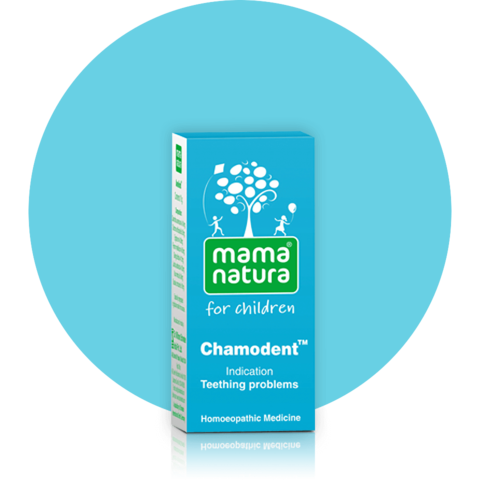Chamodent™ for Teething Problems & associated symptoms

For trouble-free teething
- Controls inflammation of the gums
- Relieves throbbing pain in the teeth and gum
- Takes care of associated diarrhoea, colic and flatulence
- Controls restlessness and irritability.
M.R.P. Rs. 100.00
Composition
Each tablet of 100 mg contains:
- Belladonna 6x 15mg
- Chamomilla 6x 15mg
- Ferrum phosphoricum 6x 15mg
- Hepar sulphur 12x 15mg
- Pulsatilla nigricans 6x 15mg
- Excipient Q.S
Proven indications

Belladonna
Therapeutic action / characteristics:
- Throbbing pain in teeth, gum-boil
- Grinding of teeth, red-hot face, pain in middle or external ear and child cries in sleep.

Chamomilla
Therapeutic action / characteristics:
- Acute feverish inflammations
- Painful, red and swollen gums
- Sleeplessness and restlessness

Ferrum phosphoricum
Therapeutic action / characteristics:
- An all rounder for inflammation conditions
- Febrile conditions, anaemia

Hepar sulphur
Therapeutic action / characteristics:
- Covers conditions like painful gums, throat infection, tonsillitis
Dosage: Unless otherwise prescribed by the physician,
- During the teething problems, give 2-3 tablets 3-4 times a day.
In very acute cases, 3 tablets every hour can be given which should be reduced when the symptoms diminish to the initial dosage.
Side effects: No side effects of Chamodent™ are known.
Contra-indications: No contra-indications for the use of Chamodent™ are known.
Presentation: Bottle of 10g of tablets
Teething discomfort usually starts within baby’s first six months.
The pain and discomfort of teething is something every baby – and mum – has to endure. The crying and restlessness, as well as fever, rashes and upset tummies, can be worrying, and may disturb sleep as well as family life. Fortunately, teething symptoms soon subside once the tooth is through. As a mum or dad though, you will want to do all you can to help baby through the distress as safely, gently and effectively as possible.
Teething discomfort is distressing for the baby & the whole family
A baby will usually feel pain from a few days before a new tooth starts to push through the gums. Once through, the pain and discomfort starts to subside.
Drooling and biting or chewing on hard objects are classic signs that a baby is teething. A baby will produce lots of saliva which can sometimes irritate the skin around the mouth.
For many babies, the pain seems to be worse at night. Thus, waking at night during teething is common.
Teething - common signs and symptoms
- Increased salivation / drooling (often begins before teething starts)
- Baby's gums are swollen, red, sensitive and aching
- Bites and chews on solid objects
- Baby's cheeks are sometimes hot and flushed
- Mild rash around the mouth due to skin irritation caused by excessive drooling
- Earache
- The child is irritable (e.g. weepy, restless, cranky, aggressive, …)
- Sleeping problems
- Gastrointestinal symptoms (e.g. diarrhoea)
- Slight rise in body temperature (”teething fever”)
Teething – pain, crying, and general discomfort
Teething is a normal part of development usually starting at any point in the first six months of an infant’s life. The lower front teeth (lower central incisors) are normally the first to appear, followed by the top front teeth (upper central incisors). All 20 deciduous or milk teeth should be in place by about 30 months. Teething may be experienced a second time when permanent teeth start to erupt at the age of around six years.
As good oral hygiene routines should also be established early on, a consultation on teething is a great opportunity to get advice on cleaning teeth as soon as they start to appear. For young infants, cleaning might be easiest with a soft wet cloth until a brush can be used.
Teething: Possible treatments
Local
Local interventions:
- Rub or massage baby's gums with a clean finger
- Offer teething aids (“teethers”) such as teething rings, toys or biscuits to chew on
- Offer chilled foods, such as yoghurt or purred fruits
- Good dental care is starting with baby´s first tooth:
- clean the baby´s teeth once a day with a soft, wet washing cloth
- at 12 months of age, a small soft toothbrush with water can be used
- add a small dab of toothpaste (there are special preparations for children) as the child grows older
Avoid continuous and extended exposure to sugared liquids (“baby bottle tooth decay”). First dental visit should occur by the age of one or within 6 months after eruption of first tooth.
Pharmaceutical
Pharmaceutical interventions:
- Local anaesthetics in teething gels to rub on the painful and swollen baby´s gums
- Analgetics (e.g. paracetamol, ibuprofen)
Behavioural
Behavioural interventions:
- Try to calm down the child by offering an atmosphere of security (“calmness, closeness, cuddling”)
- Avoid causing the child additional stress
Naturopathic
Naturopathic interventions:
- Homeopathic medicines such as e.g. Chamodent™
Please find some useful answers to your questions as follows:
What are possible side-effects of Chamodent™?
No side effects of Chamodent™ are known
Can Chamodent™ be taken alongside other medication?
Yes, there is no problem to take Chamodent™ in combination with other medication that have been prescribed by a physician or alternative practitioner. Interactions have not been observed.
What are the key benefits of Chamodent™?
- Developed especially for use in children
- suitable from birth
- safe and gentle with virtually no side-effects
- excellent tolerability
- clinically effective
- easy to take / administer:
- no need to swallow
- tablets dissolve quickly within the mouthly
Where can you get Chamodent™?
As Chamodent™ is classified as a medicinal product, it is available from homoeopathic pharmacies. It is also made available from our website
